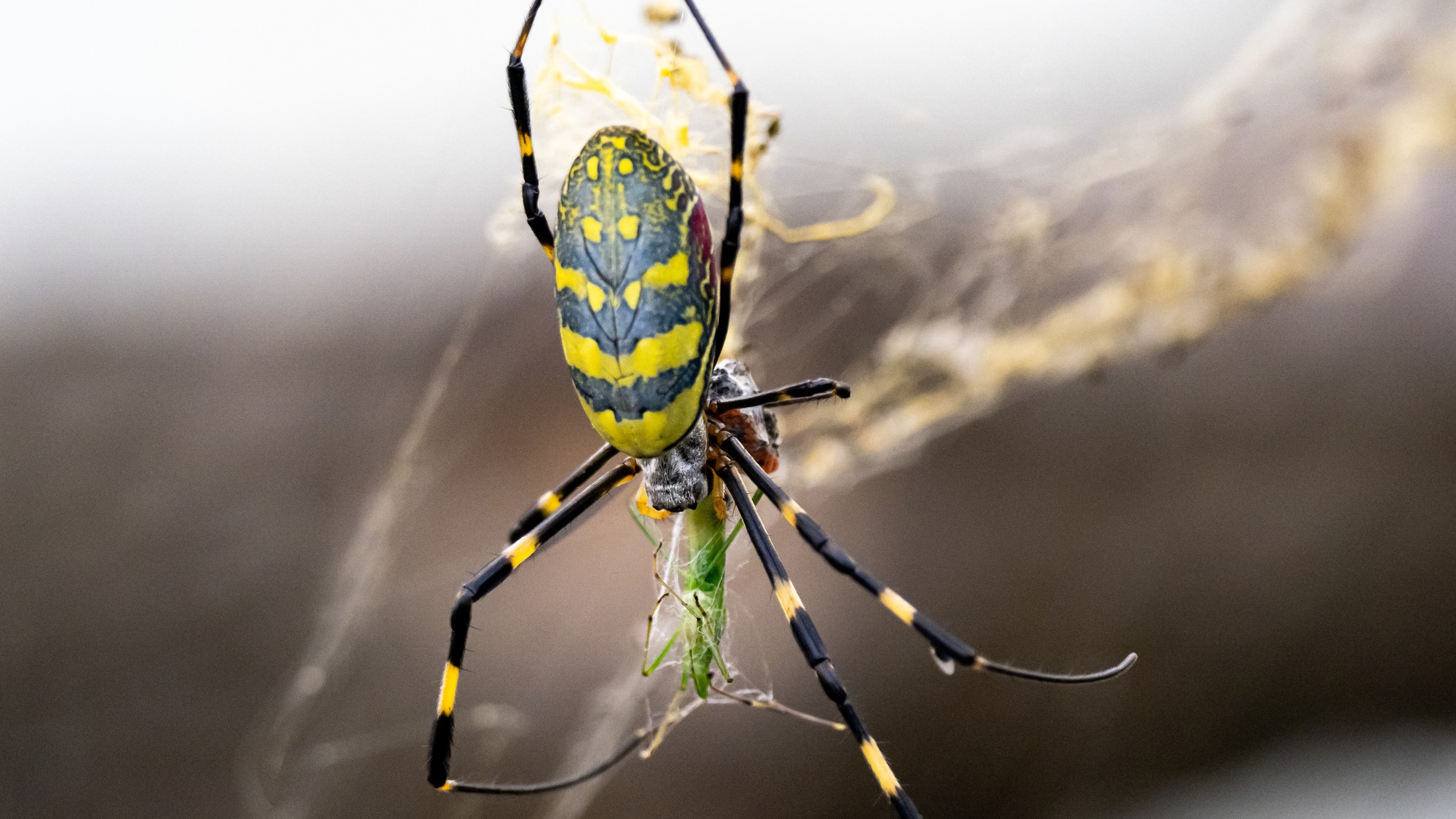Invasive giant spider in US is actually 'shyest ever documented,' study finds
Joro spiders have spread all over Georgia and its neighboring states, but they don't owe their success to a combative nature — quite the opposite, in fact.

Giant, invasive Jorō spiders that are spreading throughout the southeastern United States could be the "shyest ever documented," meaning they don't owe their success to aggression, a new study finds.
Jorō spiders (Trichonephila clavata) first appeared in the U.S. in 2013, when they were accidentally brought across from eastern Asia in a shipping container, according to a study published May 15 in the journal Arthropoda. The yellow and blue-black critters are now found all over Georgia and its neighboring states, where they weave exceptionally large webs measuring up to 6.5 feet in diameter (2 meters) that are sometimes interlinked to form "colonial" webs.
"Most people think 'invasive' and 'aggressive' are synonymous," study co-author Amitesh Anerao, an undergraduate biology major at the University of Georgia, said in a statement. "People were freaking out about the Jorō spiders at first."
The species' explosive spread suggested it could be innately combative and threatening. "One of the ways that people think this spider could be affecting other species is that it's aggressive and out-competing all the other native spiders," lead author Andy Davis, an assistant research scientist at the University of Georgia's Odum School of Ecology, said in the statement.
But it turns out that Jorō spiders, whose bodies without the legs can measure up to 1.2 inches (30 millimeters), are quite the opposite — and possibly the shyest spiders on record.
Related: What is the deadliest spider in the world?

To determine their boldness and resilience to mild stress, the researchers collected Jorō spiders and exposed them to two consecutive, gentle puffs of air from a turkey baster. They measured the duration of the spiders' freeze response, or thanatosis — when spiders remain still for a period of time after a disturbance — and compared it with that of nine other North American spiders.
Sign up for the Live Science daily newsletter now
Get the world’s most fascinating discoveries delivered straight to your inbox.
The researchers were baffled to find that Jorō spiders remained motionless for more than an hour after the disturbance. The shortest freeze responses lasted 11 minutes, which was still seven times longer than the average response of other spiders (one to two minutes). "They basically shut down and wait for the disturbance to go away," Davis said.
Only one other species closely related to Jorō spiders, the golden silk spider (T. clavipes), displayed a similarly lengthy startle reaction. "We ourselves were surprised when conducting the tests because the reactions of the Trichonephila spiders differed so greatly from the published literature," the researchers wrote in the study. "We hypothesize that this prolonged response must be an innate trait of this genus."
Spider freeze time is a good estimate of how threatened they feel, according to the study. Spiders that stay still for longer are thought to be shyer, and those that resume activity soon after a disturbance, bolder. "Our paper shows that these spiders are really more afraid of you than the reverse," Davis said.
Despite their timidity, Jorō spiders appear to be highly tolerant to human environments and to have successfully expanded their range.
So instead of aggression, their spread could be down to their "incredible reproductive potential," Davis said. "They're simply outbreeding everybody else. It's not because they're displacing native spiders or kicking them out of their own webs."
Arachnophobes might hate the look of them, but Jorōs are relatively harmless and don't bite unless they are cornered. The giant spiders are unlikely to budge from the southeast. "They're so good at living with humans that they're probably not going away anytime soon," Anerao said.

Sascha is a U.K.-based staff writer at Live Science. She holds a bachelor’s degree in biology from the University of Southampton in England and a master’s degree in science communication from Imperial College London. Her work has appeared in The Guardian and the health website Zoe. Besides writing, she enjoys playing tennis, bread-making and browsing second-hand shops for hidden gems.










